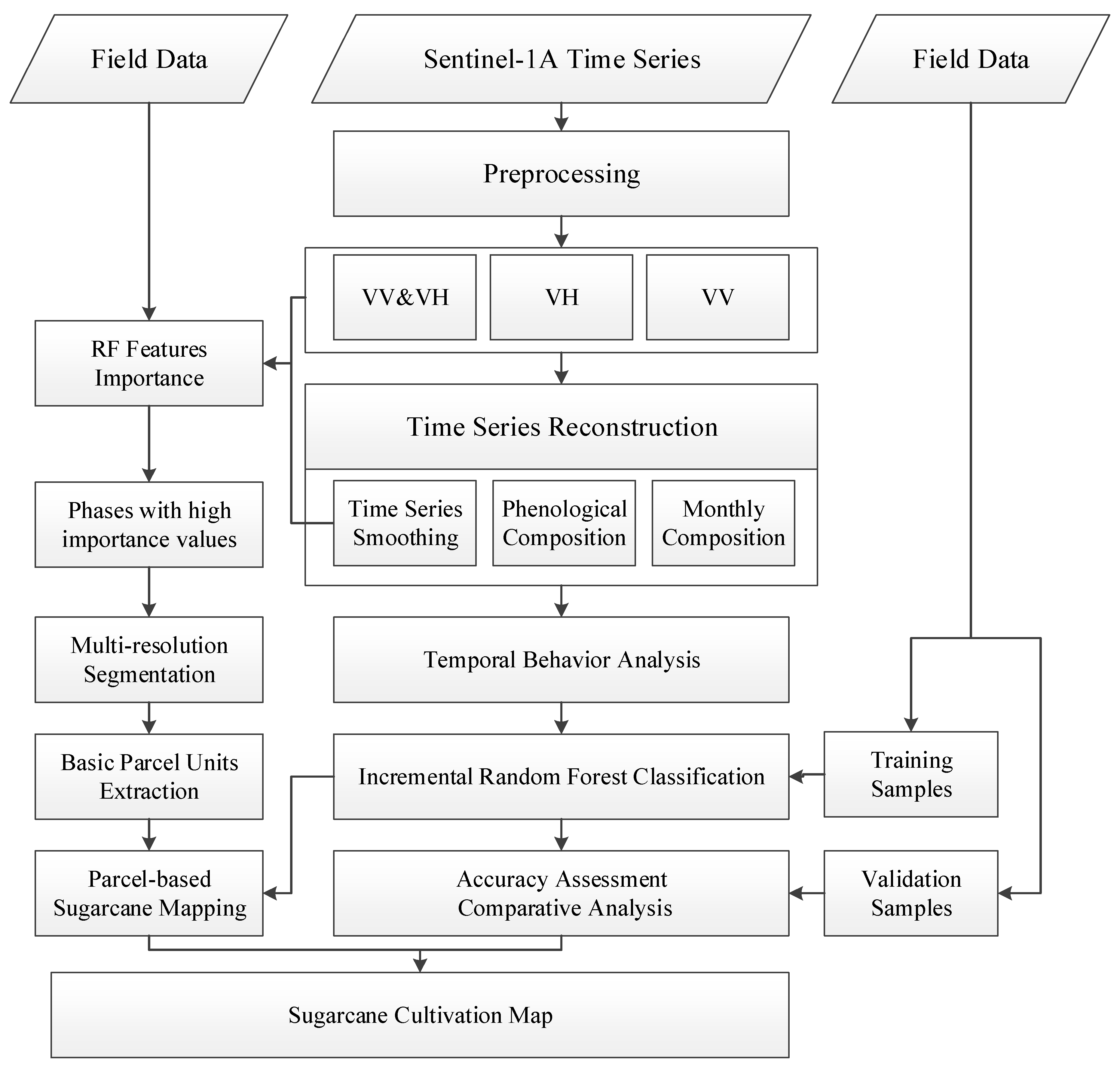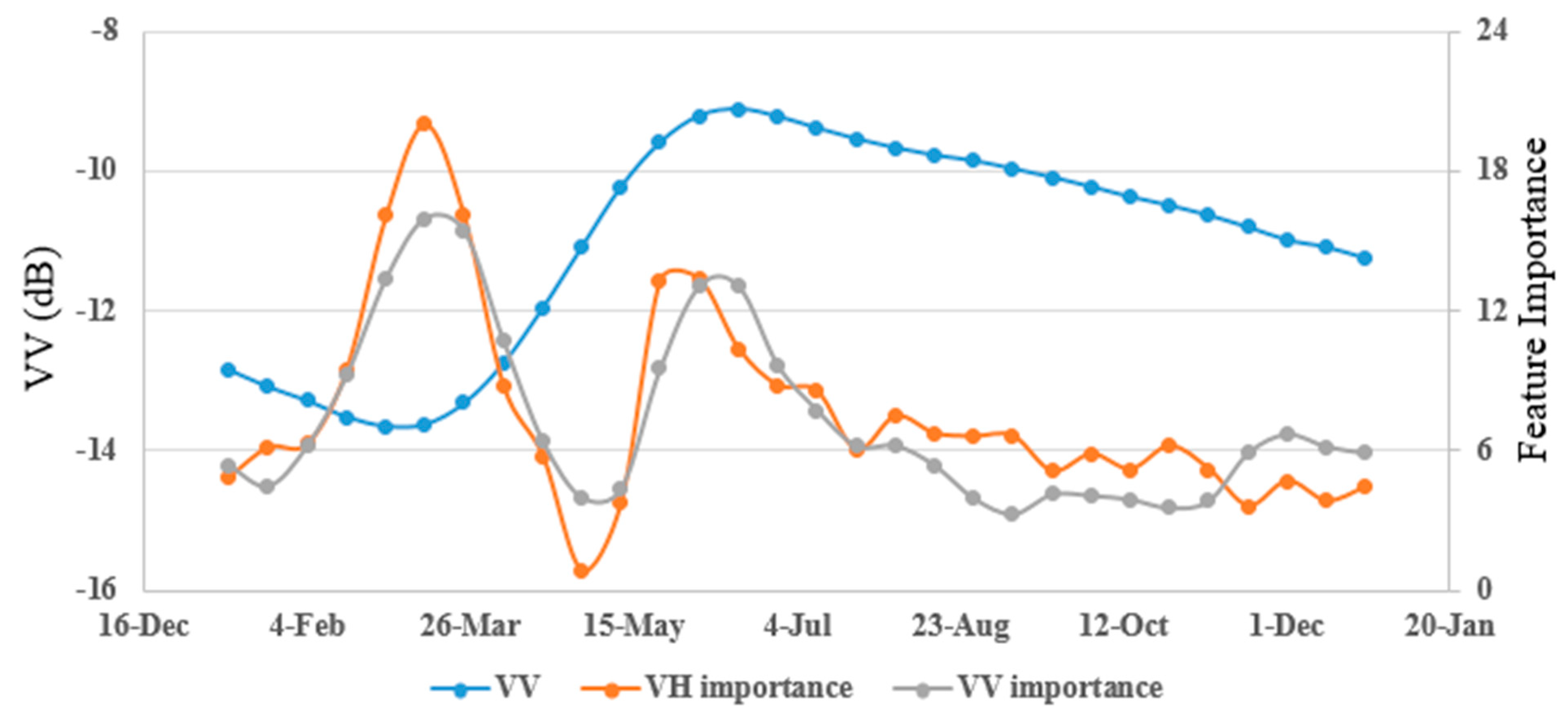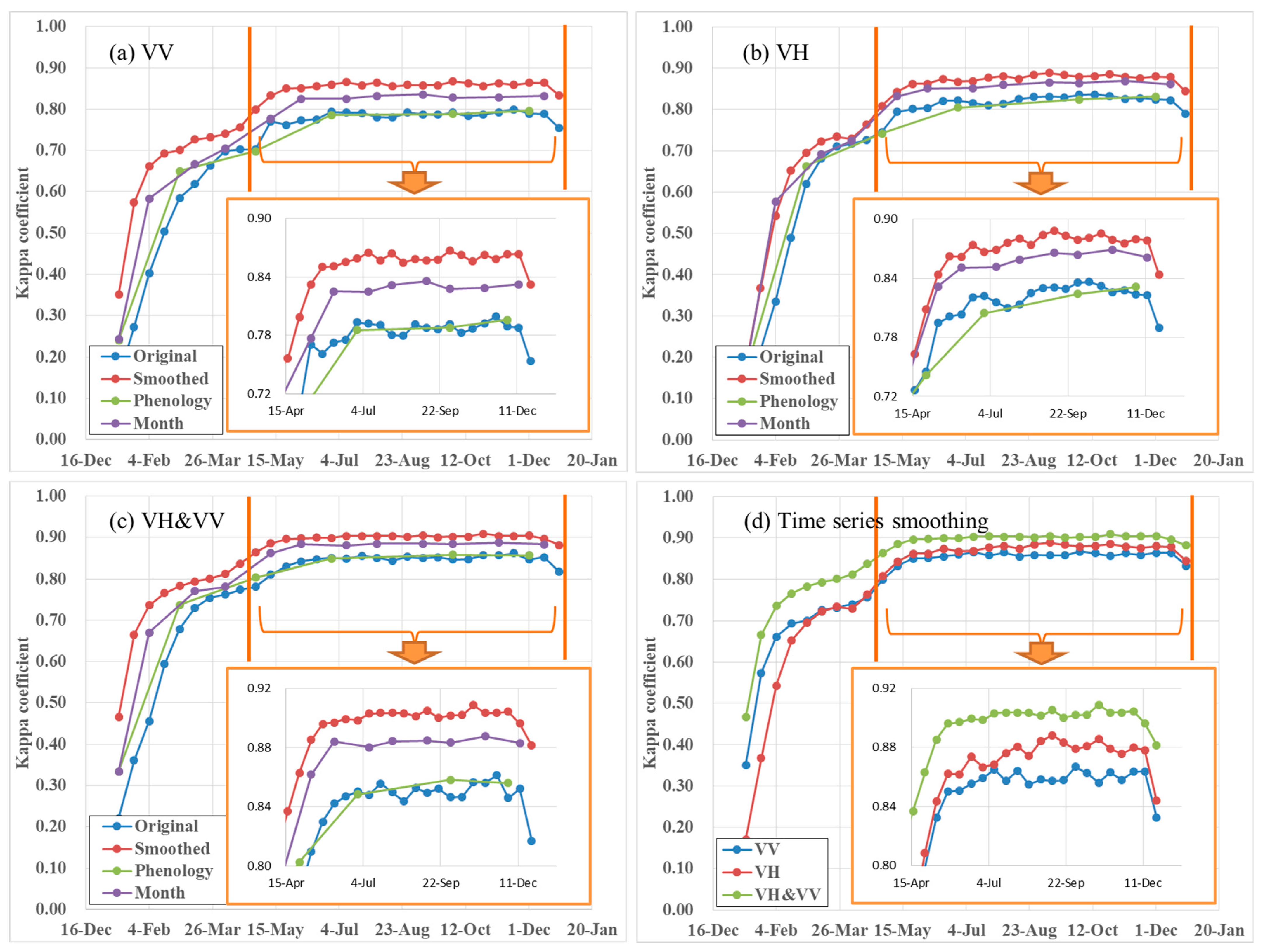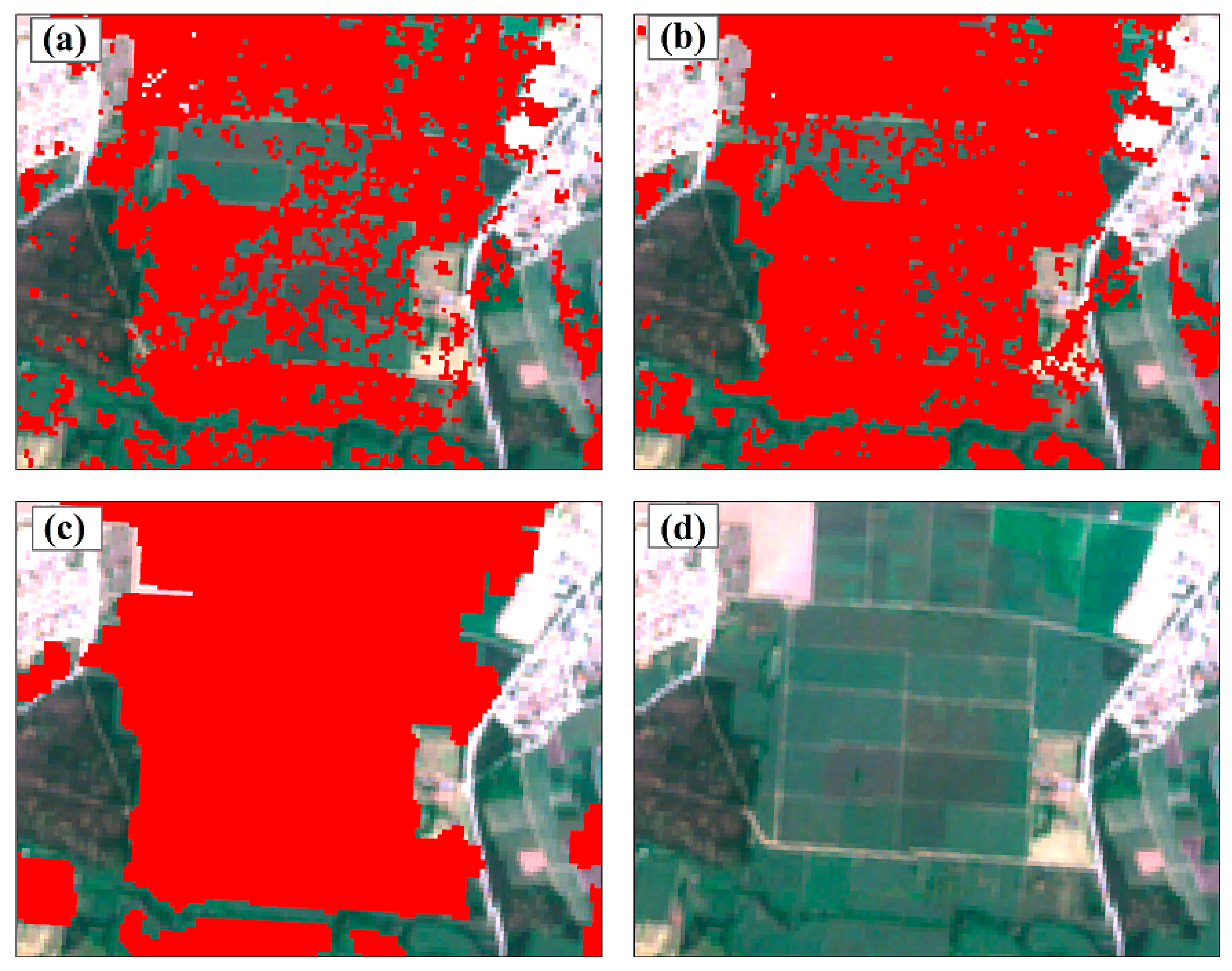Parcel-Based Sugarcane Mapping Using Smoothed Sentinel-1 Time Series Data
Abstract
:1. Introduction
2. Materials and Methods
2.1. Study Site
Sugarcane Calendar
2.2. Datasets
2.2.1. Sentinel 1 Data and Preprocessing
2.2.2. Field Survey
2.3. Experimental Design
2.4. Methods
2.4.1. Reconstruction of Time Series Sentinel-1A Data
2.4.2. Incremental Classification
2.4.3. Feature Importance Assessment
2.4.4. Parcel-Based Classification Using Multi-Resolution Segmentation
2.4.5. Accuracy Assessment
3. Results
3.1. Temporal Behavior of SAR Backscattering over Vegetation
3.2. Performance of Time Series Smoothing
3.3. Feature Importance
3.4. Comparison of Classification Accuracy
3.5. Sugarcane Mapping Results
4. Discussion
4.1. New Application Paradigm of Time Series SAR Data for Sugarcane Mapping
4.2. Temporal Importance and Early Season Mapping
4.3. Limitations and Prospects
5. Conclusions
Author Contributions
Funding
Data Availability Statement
Acknowledgments
Conflicts of Interest
References
- Sindhu, R.; Gnansounou, E.; Binod, P.; Pandey, A. Bioconversion of sugarcane crop residue for value added products—An overview. Renew. Energy 2016, 98, 203–215. [Google Scholar] [CrossRef]
- Cardona, C.A.; Quintero, J.A.; Paz, I.C. Production of bioethanol from sugarcane bagasse: Status and perspectives. Bioresour. Technol. 2010, 101, 4754–4766. [Google Scholar] [CrossRef]
- Pan, S.; Zabed, H.M.; Wei, Y.; Qi, X. Technoeconomic and environmental perspectives of biofuel production from sugarcane bagasse: Current status, challenges and future outlook. Ind. Crops Prod. 2022, 188, 115684. [Google Scholar] [CrossRef]
- OECD-FAO. OECD-FAO Agricultural Outlook 2022–2031; Food & Agriculture Org.: Rome, Italy, 2022. [Google Scholar]
- Cheavegatti-Gianotto, A.; de Abreu, H.M.; Arruda, P.; Bespalhok Filho, J.C.; Burnquist, W.L.; Creste, S.; di Ciero, L.; Ferro, J.A.; de Oliveira Figueira, A.V.; de Sousa Filgueiras, T.; et al. Sugarcane (Saccharum x officinarum): A reference study for the regulation of genetically modified cultivars in brazil. Trop. Plant Biol. 2011, 4, 62–89. [Google Scholar] [CrossRef]
- Som-ard, J.; Atzberger, C.; Izquierdo-Verdiguier, E.; Vuolo, F.; Immitzer, M. Remote sensing applications in sugarcane cultivation: A review. Remote Sens. 2021, 13, 4040. [Google Scholar] [CrossRef]
- El Chami, D.; Daccache, A.; El Moujabber, M. What are the impacts of sugarcane production on ecosystem services and human well-being? A review. Ann. Agric. Sci. 2020, 65, 188–199. [Google Scholar] [CrossRef]
- Dinesh Babu, K.S.; Janakiraman, V.; Palaniswamy, H.; Kasirajan, L.; Gomathi, R.; Ramkumar, T.R. A short review on sugarcane: Its domestication, molecular manipulations and future perspectives. Genet. Resour. Crop. Evol. 2022, 69, 2623–2643. [Google Scholar] [CrossRef] [PubMed]
- Cock, J. Sugarcane growth and development. Int. Sugar J. 2003, 105, 540–552. [Google Scholar]
- FAOSTAT. Sugarcane Production in 2020, Crops/Regions/World List/Production Quantity (Pick Lists); FAOSTAT: Rome, Italy, 2022. [Google Scholar]
- Defante, L.R.; Vilpoux, O.F.; Sauer, L. Rapid expansion of sugarcane crop for biofuels and influence on food production in the first producing region of brazil. Food Policy 2018, 79, 121–131. [Google Scholar] [CrossRef]
- Adami, M.; Rudorff, B.F.T.; Freitas, R.M.; Aguiar, D.A.; Sugawara, L.M.; Mello, M.P. Remote sensing time series to evaluate direct land use change of recent expanded sugarcane crop in brazil. Sustainability 2012, 4, 574–585. [Google Scholar] [CrossRef]
- Zheng, Y.; dos Santos Luciano, A.C.; Dong, J.; Yuan, W. High-resolution map of sugarcane cultivation in brazil using a phenology-based method. Earth Syst. Sci. Data 2022, 14, 2065–2080. [Google Scholar] [CrossRef]
- Cherubin, M.R.; Carvalho, J.L.; Cerri, C.E.; Nogueira, L.A.; Souza, G.M.; Cantarella, H. Land use and management effects on sustainable sugarcane-derived bioenergy. Land 2021, 10, 72. [Google Scholar] [CrossRef]
- Silalertruksa, T.; Gheewala, S.H. Land-water-energy nexus of sugarcane production in thailand. J. Clean. Prod. 2018, 182, 521–528. [Google Scholar] [CrossRef]
- Jaiswal, D.; De Souza, A.P.; Larsen, S.; LeBauer, D.S.; Miguez, F.E.; Sparovek, G.; Bollero, G.; Buckeridge, M.S.; Long, S.P. Brazilian sugarcane ethanol as an expandable green alternative to crude oil use. Nat. Clim. Chang. 2017, 7, 788–792. [Google Scholar] [CrossRef]
- Zhang, H.; Anderson, R.G.; Wang, D. Satellite-based crop coefficient and regional water use estimates for hawaiian sugarcane. Field Crops Res. 2015, 180, 143–154. [Google Scholar] [CrossRef]
- Mello, F.F.C.; Cerri, C.E.P.; Davies, C.A.; Holbrook, N.M.; Paustian, K.; Maia, S.M.F.; Galdos, M.V.; Bernoux, M.; Cerri, C.C. Payback time for soil carbon and sugar-cane ethanol. Nat. Clim. Chang. 2014, 4, 605–609. [Google Scholar] [CrossRef]
- Loarie, S.R.; Lobell, D.B.; Asner, G.P.; Mu, Q.; Field, C.B. Direct impacts on local climate of sugar-cane expansion in Brazil. Nat. Clim. Chang. 2011, 1, 105–109. [Google Scholar] [CrossRef]
- Wang, J.; Xiao, X.; Liu, L.; Wu, X.; Qin, Y.; Steiner, J.L.; Dong, J. Mapping sugarcane plantation dynamics in Guangxi, China, by time series sentinel-1, sentinel-2 and landsat images. Remote Sens. Environ. 2020, 247, 111951. [Google Scholar] [CrossRef]
- Abdel-Rahman, E.M.; Ahmed, F.B. The application of remote sensing techniques to sugarcane (Saccharum spp. Hybrid) production: A review of the literature. Int. J. Remote Sens. 2008, 29, 3753–3767. [Google Scholar] [CrossRef]
- Zhan, P.; Zhu, W.; Li, N. An automated rice mapping method based on flooding signals in synthetic aperture radar time series. Remote Sens. Environ. 2021, 252, 112112. [Google Scholar] [CrossRef]
- Mateo-Sanchis, A.; Piles, M.; Muñoz-Marí, J.; Adsuara, J.E.; Pérez-Suay, A.; Camps-Valls, G. Synergistic integration of optical and microwave satellite data for crop yield estimation. Remote Sens. Environ. 2019, 234, 111460. [Google Scholar] [CrossRef] [PubMed]
- Joshi, N.; Baumann, M.; Ehammer, A.; Fensholt, R.; Grogan, K.; Hostert, P.; Jepsen, M.R.; Kuemmerle, T.; Meyfroidt, P.; Mitchard, E.T.A.; et al. A review of the application of optical and radar remote sensing data fusion to land use mapping and monitoring. Remote Sens. 2016, 8, 70. [Google Scholar] [CrossRef]
- de Souza, C.H.W.; Cervi, W.R.; Brown, J.C.; Rocha, J.V.; Lamparelli, R.A.C. Mapping and evaluating sugarcane expansion in Brazil’s savanna using modis and intensity analysis: A case-study from the state of tocantins. J. Land Use Sci. 2017, 12, 457–476. [Google Scholar] [CrossRef]
- Xavier, A.C.; Rudorff, B.F.T.; Shimabukuro, Y.E.; Berka, L.M.S.; Moreira, M.A. Multi-temporal analysis of modis data to classify sugarcane crop. Int. J. Remote Sens. 2006, 27, 755–768. [Google Scholar] [CrossRef]
- Singh, R.; Patel, N.R.; Danodia, A. Deriving phenological metrics from landsat-oli for sugarcane crop type mapping: A case study in North India. J. Indian Soc. Remote Sens. 2022, 50, 1021–1030. [Google Scholar] [CrossRef]
- dos Luciano, A.C.; Picoli, M.C.A.; Rocha, J.V.; Duft, D.G.; Lamparelli, R.A.C.; Leal, M.R.L.V.; Le Maire, G. A generalized space-time obia classification scheme to map sugarcane areas at regional scale, using landsat images time-series and the random forest algorithm. Int. J. Appl. Earth Obs. Geoinf. 2019, 80, 127–136. [Google Scholar] [CrossRef]
- Zhou, Z.; Huang, J.; Wang, J.; Zhang, K.; Kuang, Z.; Zhong, S.; Song, X. Object-oriented classification of sugarcane using time-series middle-resolution remote sensing data based on adaboost. PLoS ONE 2015, 10, e0142069. [Google Scholar] [CrossRef]
- Wang, J.; Huang, J.; Wang, L.; Hu, Y.; Han, P.; Huang, W. Identification of sugarcane based on object-oriented analysis using time-series HJ CCD data. Trans. Chin. Soc. Agric. Eng. 2014, 30, 145–151. [Google Scholar]
- Zheng, Y.; Li, Z.; Pan, B.; Lin, S.; Dong, J.; Li, X.; Yuan, W. Development of a phenology-based method for identifying sugarcane plantation areas in china using high-resolution satellite datasets. Remote Sens. 2022, 14, 1274. [Google Scholar] [CrossRef]
- Wang, M.; Liu, Z.; Ali Baig, M.H.; Wang, Y.; Li, Y.; Chen, Y. Mapping sugarcane in complex landscapes by integrating multi-temporal sentinel-2 images and machine learning algorithms. Land Use Policy 2019, 88, 104190. [Google Scholar] [CrossRef]
- Lin, H.; Chen, J.; Pei, Z.; Zhang, S.; Hu, X. Monitoring sugarcane growth using envisat asar data. IEEE Trans. Geosci. Remote Sens. 2009, 47, 2572–2580. [Google Scholar] [CrossRef]
- Baghdadi, N.; Boyer, N.; Todoroff, P.; El Hajj, M.; Bégué, A. Potential of sar sensors TerraSAR-X, ASAR/ENVISAT and PALSAR/ALOS for monitoring sugarcane crops on reunion island. Remote Sens. Environ. 2009, 113, 1724–1738. [Google Scholar] [CrossRef]
- Baghdadi, N.; Cresson, R.; Todoroff, P.; Moinet, S. Multitemporal observations of sugarcane by TerraSAR-X images. Sensors 2010, 10, 8899–8919. [Google Scholar] [CrossRef]
- Li, H.; Chen, J.; Liang, S.; Li, Q. Sugarcane mapping in tillering period by quad-polarization TerraSAR-X data. IEEE Geosci. Remote Sens. Lett. 2015, 12, 993–997. [Google Scholar]
- Li, H.; Han, Y.; Chen, J. Capability of multidate RADARSAT-2 data to identify sugarcane lodging. J. Appl. Remote Sens. 2019, 13, 044514. [Google Scholar] [CrossRef]
- Jiang, H.; Li, D.; Jing, W.; Xu, J.; Huang, J.; Yang, J.; Chen, S. Early season mapping of sugarcane by applying machine learning algorithms to sentinel-1a/2 time series data: A case study in Zhanjiang city, China. Remote Sens. 2019, 11, 861. [Google Scholar] [CrossRef]
- Sreedhar, R.; Varshney, A.; Dhanya, M. Sugarcane crop classification using time series analysis of optical and sar sentinel images: A deep learning approach. Remote Sens. Lett. 2022, 13, 812–821. [Google Scholar] [CrossRef]
- Zhao, H.; Chen, Z.; Jiang, H.; Jing, W.; Sun, L.; Feng, M. Evaluation of three deep learning models for early crop classification using sentinel-1a imagery time series—A case study in Zhanjiang, China. Remote Sens. 2019, 11, 2673. [Google Scholar] [CrossRef]
- Yuan, J.; Lv, X.; Li, R. A speckle filtering method based on hypothesis testing for time-series sar images. Remote Sens. 2018, 10, 1383. [Google Scholar] [CrossRef]
- Jong-Sen, L. Speckle suppression and analysis for synthetic aperture radar images. Opt. Eng. 1986, 25, 255636. [Google Scholar]
- Satalino, G.; Balenzano, A.; Mattia, F.; Davidson, M.W.J. C-band sar data for mapping crops dominated by surface or volume scattering. IEEE Geosci. Remote Sens. Lett. 2014, 11, 384–388. [Google Scholar] [CrossRef]
- Luo, C.; Qi, B.; Liu, H.; Guo, D.; Lu, L.; Fu, Q.; Shao, Y. Using time series sentinel-1 images for object-oriented crop classification in google earth engine. Remote Sens. 2021, 13, 561. [Google Scholar] [CrossRef]
- Beriaux, E.; Jago, A.; Lucau-Danila, C.; Planchon, V.; Defourny, P. Sentinel-1 time series for crop identification in the framework of the future cap monitoring. Remote Sens. 2021, 13, 2785. [Google Scholar] [CrossRef]
- Quegan, S.; Yu, J.J. Filtering of multichannel sar images. IEEE Trans. Geosci. Remote Sens. 2001, 39, 2373–2379. [Google Scholar] [CrossRef]
- Schlund, M.; Erasmi, S. Sentinel-1 time series data for monitoring the phenology of winter wheat. Remote Sens. Environ. 2020, 246, 111814. [Google Scholar] [CrossRef]
- Nasrallah, A.; Baghdadi, N.; El Hajj, M.; Darwish, T.; Belhouchette, H.; Faour, G.; Darwich, S.; Mhawej, M. Sentinel-1 data for winter wheat phenology monitoring and mapping. Remote Sens. 2019, 11, 2228. [Google Scholar] [CrossRef]
- Bazzi, H. Mapping paddy rice using sentinel-1 sar time series in Camargue, France. Remote Sens. 2019, 11, 887. [Google Scholar] [CrossRef]
- Li, S.; Xu, L.; Jing, Y.; Yin, H.; Li, X.; Guan, X. High-quality vegetation index product generation: A review of NDVI time series reconstruction techniques. Int. J. Appl. Earth Obs. Geoinf. 2021, 105, 102640. [Google Scholar] [CrossRef]
- Geng, L.; Ma, M.; Wang, X.; Yu, W.; Jia, S.; Wang, H. Comparison of eight techniques for reconstructing multi-satellite sensor time-series NDVI data sets in the Heihe River Basin, China. Remote Sens. 2014, 6, 2024–2049. [Google Scholar] [CrossRef]
- Malhi, R.K.M.; Kiran, G.S.; Shah, M.N.; Mistry, N.V.; Bhavsar, V.H.; Singh, C.P.; Bhattarcharya, B.K.; Townsend, P.A.; Mohan, S. Applicability of smoothing techniques in generation of phenological metrics of Tectona grandis L. Using NDVI time series data. Remote Sens. 2021, 13, 3343. [Google Scholar] [CrossRef]
- Soudani, K.; Delpierre, N.; Berveiller, D.; Hmimina, G.; Vincent, G.; Morfin, A.; Dufrêne, É. Potential of c-band synthetic aperture radar sentinel-1 time-series for the monitoring of phenological cycles in a deciduous forest. Int. J. Appl. Earth Obs. Geoinf. 2021, 104, 102505. [Google Scholar] [CrossRef]
- Stendardi, L.; Karlsen, S.R.; Niedrist, G.; Gerdol, R.; Zebisch, M.; Rossi, M.; Notarnicola, C. Exploiting time series of sentinel-1 and sentinel-2 imagery to detect meadow phenology in mountain regions. Remote Sens. 2019, 11, 542. [Google Scholar] [CrossRef]
- Wang, Y.; Fang, S.; Zhao, L.; Huang, X.; Jiang, X. Parcel-based summer maize mapping and phenology estimation combined using sentinel-2 and time series sentinel-1 data. Int. J. Appl. Earth Obs. Geoinf. 2022, 108, 102720. [Google Scholar] [CrossRef]
- Sonobe, R. Parcel-based crop classification using multi-temporal TerraSAR-X dual polarimetric data. Remote Sens. 2019, 11, 1148. [Google Scholar] [CrossRef]
- Snevajs, H.; Charvat, K.; Onckelet, V.; Kvapil, J.; Zadrazil, F.; Kubickova, H.; Seidlova, J.; Batrlova, I. Crop detection using time series of Sentinel-2 and Sentinel-1 and existing land parcel information systems. Remote Sens. 2022, 14, 1095. [Google Scholar] [CrossRef]
- Cai, Z.; Jönsson, P.; Jin, H.; Eklundh, L. Performance of smoothing methods for reconstructing NDVI time-series and estimating vegetation phenology from modis data. Remote Sens. 2017, 9, 1271. [Google Scholar] [CrossRef]
- Shao, Y.; Lunetta, R.S.; Wheeler, B.; Iiames, J.S.; Campbell, J.B. An evaluation of time-series smoothing algorithms for land-cover classifications using modis-NDVI multi-temporal data. Remote Sens. Environ. 2016, 174, 258–265. [Google Scholar] [CrossRef]
- Cleveland, R.B.; Cleveland, W.S.; McRae, J.E.; Terpenning, I. Stl: A seasonal-trend decomposition. J. Off. Stat 1990, 6, 3–73. [Google Scholar]
- Cleveland, W.S.; Grosse, E.; Shyu, W.M. Local regression models. In Statistical Models in S; Routledge: Oxfordshire, UK, 2017; pp. 309–376. [Google Scholar]
- Savitzky, A.; Golay, M.J.E. Smoothing and differentiation of data by simplified least squares procedures. Anal. Chem. 1964, 36, 1627–1639. [Google Scholar] [CrossRef]
- Ruefenacht, B. Comparison of three landsat tm compositing methods: A case study using modeled tree canopy cover. Photogramm. Eng. Remote Sens. 2016, 82, 199–211. [Google Scholar] [CrossRef]
- Luo, C.; Liu, H.-J.; Lu, L.-P.; Liu, Z.-R.; Kong, F.-C.; Zhang, X.-L. Monthly composites from sentinel-1 and sentinel-2 images for regional major crop mapping with google earth engine. J. Integr. Agric. 2021, 20, 1944–1957. [Google Scholar] [CrossRef]
- Lindsay, E.; Frauenfelder, R.; Rüther, D.; Nava, L.; Rubensdotter, L.; Strout, J.; Nordal, S. Multi-temporal satellite image composites in google earth engine for improved landslide visibility: A case study of a glacial landscape. Remote Sens. 2022, 14, 2301. [Google Scholar] [CrossRef]
- Rahmati, A.; Zoej, M.J.V.; Dehkordi, A.T. Early identification of crop types using sentinel-2 satellite images and an incremental multi-feature ensemble method (case study: Shahriar, Iran). Adv. Space Res. 2022, 70, 907–922. [Google Scholar] [CrossRef]
- Inglada, J.; Vincent, A.; Arias, M.; Marais-Sicre, C. Improved early crop type identification by joint use of high temporal resolution sar and optical image time series. Remote Sens. 2016, 8, 362. [Google Scholar] [CrossRef]
- Liaw, A.; Wiener, M. Classification and regression by randomforest. R News 2002, 2, 18–22. [Google Scholar]
- Breiman, L. Random forests. Mach. Learn. 2001, 45, 5–32. [Google Scholar] [CrossRef]
- Dobrinić, D.; Gašparović, M.; Medak, D. Sentinel-1 and 2 time-series for vegetation mapping using random forest classification: A case study of Northern Croatia. Remote Sens. 2021, 13, 2321. [Google Scholar] [CrossRef]
- Baatz, M. Multi resolution segmentation: An optimum approach for high quality multi scale image segmentation. In Beutrage Zum AGIT-Symposium; Salzburg: Heidelberg, Germany, 2000; pp. 12–23. [Google Scholar]
- eCognition Developer. T. 9.0 User Guide; Trimble Germany GmbH: Munich, Germany, 2014. [Google Scholar]
- Ma, L.; Cheng, L.; Li, M.; Liu, Y.; Ma, X. Training set size, scale, and features in geographic object-based image analysis of very high resolution unmanned aerial vehicle imagery. ISPRS J. Photogramm. Remote Sens. 2015, 102, 14–27. [Google Scholar] [CrossRef]
- Lyu, H.; Lu, H.; Mou, L.; Li, W.; Wright, J.; Li, X.; Li, X.; Zhu, X.X.; Wang, J.; Yu, L.; et al. Long-term annual mapping of four cities on different continents by applying a deep information learning method to landsat data. Remote Sens. 2018, 10, 471. [Google Scholar] [CrossRef]
- Li, C.; Chen, W.; Wang, Y.; Wang, Y.; Ma, C.; Li, Y.; Li, J.; Zhai, W. Mapping winter wheat with optical and sar images based on google earth engine in Henan province, China. Remote Sens. 2022, 14, 284. [Google Scholar] [CrossRef]
- Qadir, A.; Skakun, S.; Eun, J.; Prashnani, M.; Shumilo, L. Sentinel-1 time series data for sunflower (Helianthus annuus) phenology monitoring. Remote Sens. Environ. 2023, 295, 113689. [Google Scholar] [CrossRef]
- Wang, M.; Wang, J.; Chen, L.; Du, Z. Mapping paddy rice and rice phenology with sentinel-1 sar time series using a unified dynamic programming framework. Open Geosci. 2022, 14, 414–428. [Google Scholar] [CrossRef]
- Yeasin, M.; Haldar, D.; Kumar, S.; Paul, R.K.; Ghosh, S. Machine learning techniques for phenology assessment of sugarcane using conjunctive sar and optical data. Remote Sens. 2022, 14, 3249. [Google Scholar] [CrossRef]
- Nihar, A.; Patel, N.R.; Pokhariyal, S.; Danodia, A. Sugarcane crop type discrimination and area mapping at field scale using sentinel images and machine learning methods. J. Indian Soc. Remote Sens. 2022, 50, 217–225. [Google Scholar] [CrossRef]
- Araujo Picoli, M.C.; Camargo Lamparelli, R.A.; Sano, E.E.; Batista de Mello, J.R.; Rocha, J.V. Effect of sugarcane-planting row directions on alos/palsar satellite images. GIScience Remote Sens. 2013, 50, 349–357. [Google Scholar] [CrossRef]
- Xu, S.; Zhu, X.; Chen, J.; Zhu, X.; Duan, M.; Qiu, B.; Wan, L.; Tan, X.; Xu, Y.N.; Cao, R. A robust index to extract paddy fields in cloudy regions from sar time series. Remote Sens. Environ. 2023, 285, 113374. [Google Scholar] [CrossRef]
- Xu, L.; Zhang, H.; Wang, C.; Wei, S.; Zhang, B.; Wu, F.; Tang, Y. Paddy rice mapping in thailand using time-series sentinel-1 data and deep learning model. Remote Sens. 2021, 13, 3994. [Google Scholar] [CrossRef]
- Lin, Z.; Zhong, R.; Xiong, X.; Guo, C.; Xu, J.; Zhu, Y.; Xu, J.; Ying, Y.; Ting, K.C.; Huang, J.; et al. Large-scale rice mapping using multi-task spatiotemporal deep learning and sentinel-1 sar time series. Remote Sens. 2022, 14, 699. [Google Scholar] [CrossRef]











| Pixel-Based | Parcel-Based | |||||||||
|---|---|---|---|---|---|---|---|---|---|---|
| VV | Sugarcane | Other | Total | UA | Sugarcane | Other | Total | UA | ||
| Sugarcane | 152 | 13 | 165 | 92.12% | Sugarcane | 157 | 11 | 168 | 93.45% | |
| Other | 18 | 303 | 321 | 94.39% | Other | 13 | 305 | 318 | 95.91% | |
| Total | 170 | 316 | 486 | Total | 170 | 316 | 486 | |||
| PA | 89.41% | 95.89% | PA | 92.35% | 97.52% | |||||
| OA: 93.62% | Kappa: 0.86 | OA: 95.06% | Kappa: 0.89 | |||||||
| VH | Sugarcane | Other | Total | UA | Sugarcane | Other | Total | UA | ||
| Sugarcane | 155 | 11 | 166 | 93.37% | Sugarcane | 158 | 9 | 167 | 94.61% | |
| Other | 15 | 305 | 320 | 95.31% | Other | 12 | 307 | 319 | 96.24% | |
| Total | 170 | 316 | 486 | Total | 170 | 316 | 486 | |||
| PA | 91.18% | 96.52% | PA | 92.94% | 97.15% | |||||
| OA: 94.65% | Kappa: 0.88 | OA: 95.68% | Kappa: 0.90 | |||||||
| VV & VH | Sugarcane | Other | Total | UA | Sugarcane | Other | Total | UA | ||
| Sugarcane | 158 | 10 | 168 | 94.05% | Sugarcane | 159 | 8 | 167 | 95.21% | |
| Other | 12 | 306 | 318 | 96.23% | Other | 11 | 308 | 319 | 96.55% | |
| Total | 170 | 316 | 486 | Total | 170 | 316 | 486 | |||
| PA | 92.94% | 96.84% | PA | 93.53% | 97.47% | |||||
| OA: 95.47% | Kappa: 0.90 | OA: 96.09% | Kappa: 0.91 | |||||||
Disclaimer/Publisher’s Note: The statements, opinions and data contained in all publications are solely those of the individual author(s) and contributor(s) and not of MDPI and/or the editor(s). MDPI and/or the editor(s) disclaim responsibility for any injury to people or property resulting from any ideas, methods, instructions or products referred to in the content. |
© 2024 by the authors. Licensee MDPI, Basel, Switzerland. This article is an open access article distributed under the terms and conditions of the Creative Commons Attribution (CC BY) license (https://creativecommons.org/licenses/by/4.0/).
Share and Cite
Li, H.; Wang, Z.; Sun, L.; Zhao, L.; Zhao, Y.; Li, X.; Han, Y.; Liang, S.; Chen, J. Parcel-Based Sugarcane Mapping Using Smoothed Sentinel-1 Time Series Data. Remote Sens. 2024, 16, 2785. https://doi.org/10.3390/rs16152785
Li H, Wang Z, Sun L, Zhao L, Zhao Y, Li X, Han Y, Liang S, Chen J. Parcel-Based Sugarcane Mapping Using Smoothed Sentinel-1 Time Series Data. Remote Sensing. 2024; 16(15):2785. https://doi.org/10.3390/rs16152785
Chicago/Turabian StyleLi, Hongzhong, Zhengxin Wang, Luyi Sun, Longlong Zhao, Yelong Zhao, Xiaoli Li, Yu Han, Shouzhen Liang, and Jinsong Chen. 2024. "Parcel-Based Sugarcane Mapping Using Smoothed Sentinel-1 Time Series Data" Remote Sensing 16, no. 15: 2785. https://doi.org/10.3390/rs16152785






